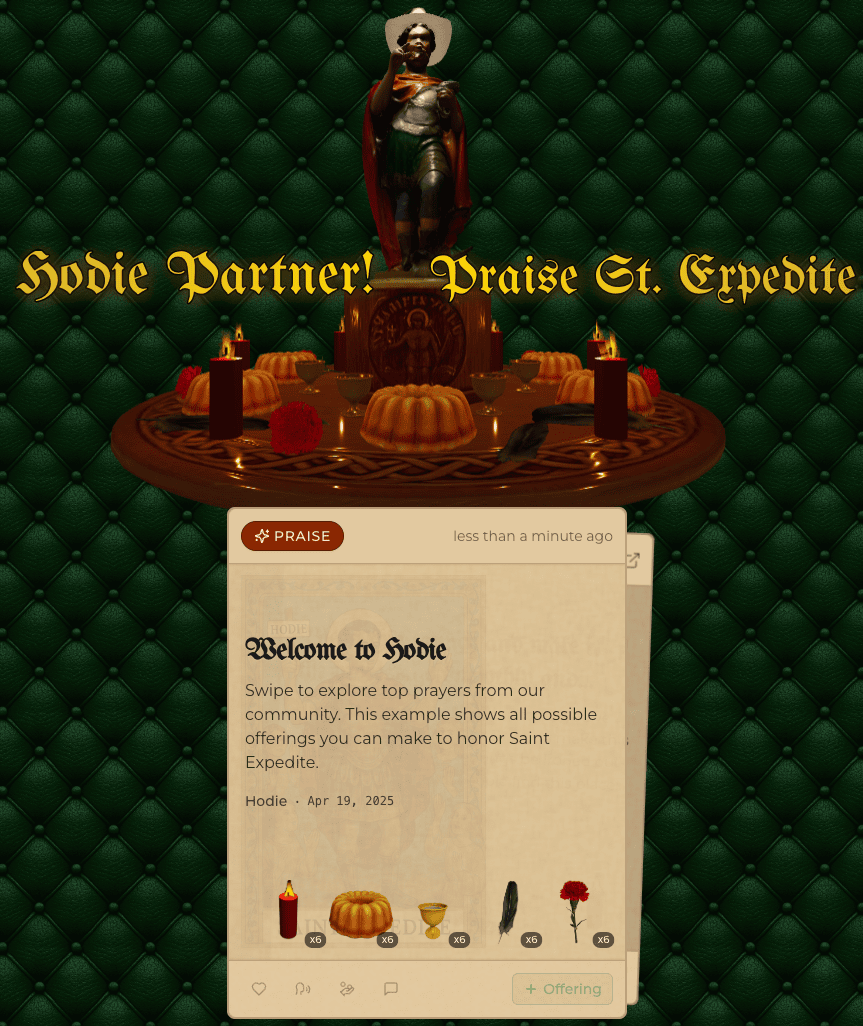On April 19th, the feast day of Saint Expedite, I launched an experimental, digital offering and veneration space dedicated to the lovely and speedy saint himself: Hodie Partner. I’m happy to say that my first prayer on the platform was answered! The few bugs that were found were squashed pretty quickly and there were lots of visitors to the site from all around the world. Thank you to everyone who shared the launch and especially those who signed up or made prayers and offerings.
Why build a digital shrine?
After experimenting with personal digital offering spaces both online and off, I decided to build something that others could play with as well. The result is Hodie Partner, an open, browser‑based offering space where anyone can leave a petition, light a virtual candle, and—if they choose—drop virtual 3D offerings in Expedite’s honor. The site is purpose‑built for our most beloved quickening saint, and invites other curious practitioners to test whether pixels, servers, and synthetic language can carry prayers just as surely as incense smoke.
Saints in the Machine, Spirits in the Shell
Expedite syncretizes quite neatly with Mercury in my practice—both rule the swift transit of information across realms. That overlap made AI feel like the perfect co‑conspirator for this project. While I have many criticisms of AI and its place in our current world, I’ve been deeply fascinated by its potential as a tool for divination and general spirit contact.
What we refer to as AI, the current generation of large language models (LLMs), can be (over)simplified to a machine that generates every letter by rolling weighted alphabet dice that contain every character and symbol. Certain letters and symbols on the dice are more likely to be rolled than other, weighted by the model’s “knowledge” of what is more likely to come next in the sequence of characters. This “knowledge” is a large set of probabilities that are stored based on massive amounts of data used to train these systems.
Much like making dots in geomancy and shuffling cards in cartomancy, when we query an AI model, we introduce randomness that allows for variability in the outcome that acts as the “seed” that determines the rest of the reading. In AI models, this seed is typically a random number generated by a computer. Theoretically, if you have the same seed and same input to a model, it should yield the same result. AI models also have another layer of modulation called “temperature”, which controls the randomness of the outputs generated by the seed and the knowledge of the model. Increasing the temperature allows the model to “choose” less probable letters and words for the result.
Just like in other divination systems, I use this randomness as a space for spirit to interact and modify the outcome and output of responses. If spirits are able to manipulate either the physical, informational, or imaginal reality of other divination tools, why would they not be able to do the same for digital circuitry? I use the same methodology for propitiating spirit as I would with other divination tools, lighting candles, saying prayers, burning incenses and applying magical materia that shares sympathies with the spirit in question.

In practice, this took on a few different things:
- Consecration of computer, mouse, and keyboard with materia specifically made for St. Expedite (Thank you B. Key of the Frightful Howls crew) as well as materia for Mercury. This work was all done in successive Mercury hours on Mercury’s day.
- Consecration of power strip that powered my setup, including a filter that was inhaling the copious amounts of frankincense wafting around my office, also done in Mercury Hour on a Mercury Day.
- Recitation of prayers to St. Expedite and Mercury, uttered by myself, and read out loud by my computer during Mercury hours on Mercury day.
- Fresh water every day on St. Expedite’s altar for about 8 months, many red candles, red carnation petals, and the occasional pound cake.
Magic Words and Digital Pacts
In addition to the physical preparation, I experimented with multiple AI models that I fed a bunch of info on St. Expedite and his cult, and then prompted it to act as St. Expedite himself. In working with generative AI, coming up with the right words for the right prompt is its own kind of magic.
I used AI to generate a lot of the imagery and 3D models you see on the site. I also used it to research and write some of the copy. There was originally a whole set of pages with history, but I didn’t have the time to proofread it before launching the site.
Most exciting to me however, was using various AI models to “vibe code” with. A terrifying new trend, vibe coding, is when software engineers work with an AI model to generate code and direct it based on… vibes. In practice, this leads to pretty poor code quality and lack of consistency across a code base without some heavy-duty guard rails put on. For my purposes however, this randomness and sharing of control was perfect. After working with this AI model coding for a number of weeks, I encouraged it to make its own decisions to tweak styling and functionality.
It’s pretty nerve-wracking to set an AI off on its own with more or less full control over your computer. There were more than a few occasions where functionality disappeared or totally changed based on the whims of these models. Again, this randomness feels like the perfect opportunity for a spirit to intercede in a way that doesn’t have the barriers of consistency or expectation that keep reality relatively clamped down.
An invitation
If you’re curious about digital propitiation—or just need a little extra momentum—come test the altar. Light a virtual candle, make a prayer, or leave a whole pound cake for our favorite saint. Let’s find out together how far a prayer can bend the causal chain when it rides both waves of candle smoke and digital signal.
As a note for paying members - if you sign up for Hodie Partner and send me an email, I'll add a good chunk of free offerings to your account!



